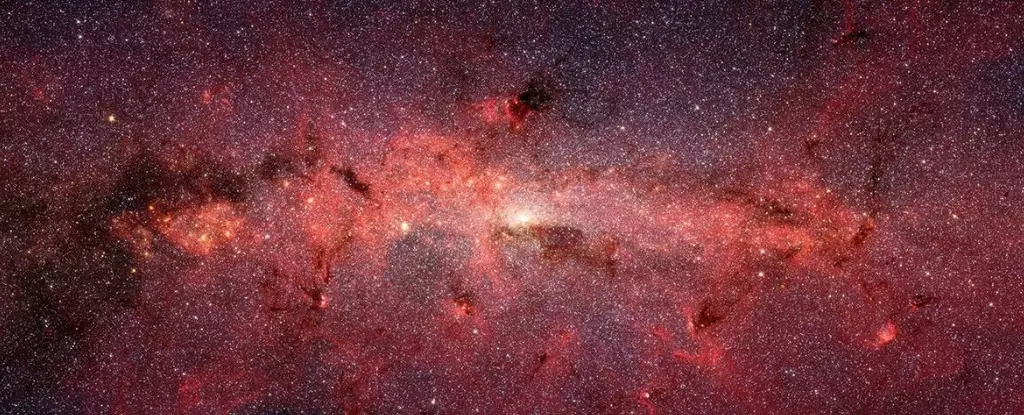In an age where we pride ourselves on our scientific advancements, the heart of our galaxy, a mere stone’s throw away in cosmic terms, holds mysteries that continue to boggle even the brightest minds in astronomy. Dive into the chaotic symphony that is the central molecular zone (CMZ) of the Milky Way, and you find not only dense clumps of molecular gas but also an enigma — a mysterious ionization process occurring at rates that leave scientists scratching their heads. The CMZ, sprawling nearly 700 light years across, is an extraordinary region teeming with star formation and cosmic phenomena, yet it paradoxically suggests chaos amidst cosmic order.
Gamma Rays: The Glimmer of the Unknown
Amidst its murky depths, the CMZ produces a haunting glow — a gamma-ray emission at 511 kilo-electronvolts, signifying the annihilation of electrons and their antimatter twins, positrons. This phenomenon, observed sporadically since the 1970s, has tantalized researchers, yet remains devoid of a definitive explanation. While many astrophysical heavyweights such as supernovas, neutron stars, and black holes have been proposed as the culprits behind this emission, none satisfyingly decode the intricacies of its patterns and intensity. Within this fraught twilight zone, the possibility arises: Could these bizarre phenomena be interlinked?
The Enigmatic Dark Matter
Ah, dark matter — the universe’s invisible puzzle piece that constitutes roughly 85% of its total mass. Unlike anything familiar, it neither emits nor absorbs light, yet its gravitational presence is as real as the ground beneath our feet. Are we, in our quest for answers, overlooking a crusader in this dark matter debate? Recent explorations into the nature of dark matter suggest that not all particles are beyond detection; small, low-mass candidates, termed sub-GeV dark matter particles, might engage with the ordinary matter present in the CMZ in ways previously underestimated.
Imagine a scenario where this exotic matter collides with its antiparticles deep within the dynamic core of our galaxy. These annihilations could generate a plume of electrons and positrons, quietly seeping into the gas, generating the mysterious ionization that puzzles scientists. This radical hypothesis conjures an intriguing possibility, where all paths lead back to one source: dark matter.
The Stunning Connection
In an epic collision of theory and observation, researchers hypothesized that the interactions between light dark matter particles could elucidate both the ionization rates and the enigmatic gamma-ray emissions from the CMZ. Through sophisticated simulations, they propose that high-energy particles, after a brief existence, effectively ionize the surrounding hydrogen molecules. In this densely packed habitat, the energy is housed locally, painting a very particular picture that correlates perfectly with observed ionization levels.
Could you imagine if this were true? The implications are nothing short of revolutionary! By positing that dark matter is at the helm of these dual phenomena, astronomers sketch a cohesive narrative that not only reconnects dots that once appeared disparate but ties them into the overarching story of our universe’s architecture.
The Future is Bright (and Dark)
As we march forward in our astronomical pursuits, the nuances surrounding the central molecular zone become more significant. The modern tools of observation are sharpening; future telescopes promise to unravel secrets that might tether the mysterious gamma rays with the observed ionization rates deftly. Each observation becomes a brushstroke in a broader cosmic painting, and the CMZ might just play gallery host to revelations that can redefine our understanding of dark matter.
If we entertain the possibility that both the 511 keV glow and ionization arise from shared origins, we hold in our hands the keys to a deeper understanding of not just our galaxy but the very fabric of reality itself. The idea that light dark matter could provide clarity into the very nature of these signals transforms the CMZ from a mere curiosity into a vital research powerhouse, urging us to reevaluate how we perceive dark matter and its role in cosmic evolution.
The galaxies above are riddled with questions begging for answers. In the seemingly unending mystery of the universe, the secrets of our own galactic backyard hold the potential to bridge gaps in knowledge, turning chaos into comprehension. The heart of the Milky Way is not just a dusty, chaotic zone but a dynamic laboratory that speaks volumes in whispers of light and energy, waiting patiently for humanity to unveil the truths encoded within.

Leave a Reply